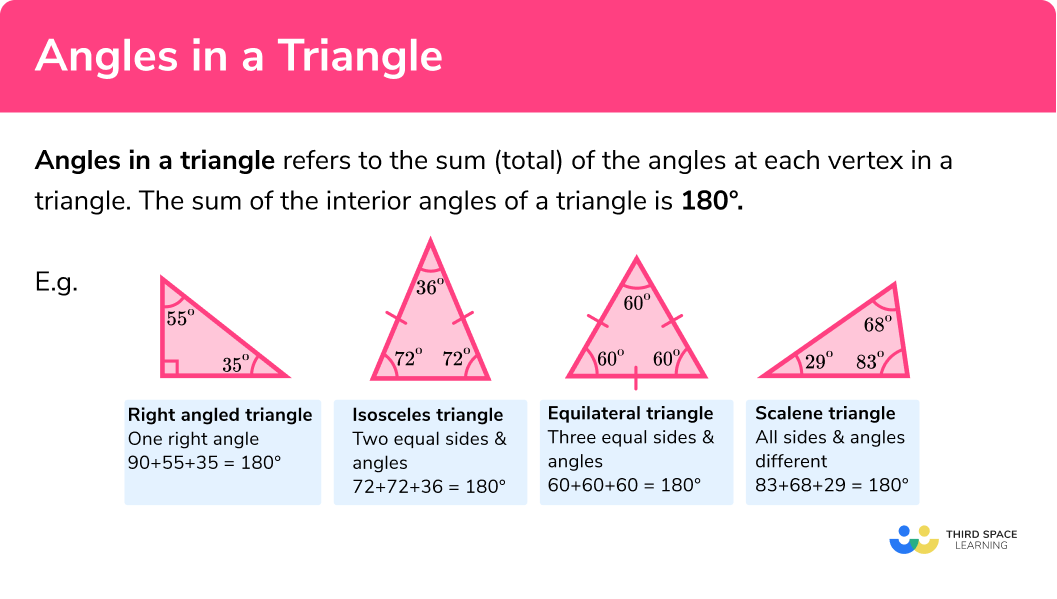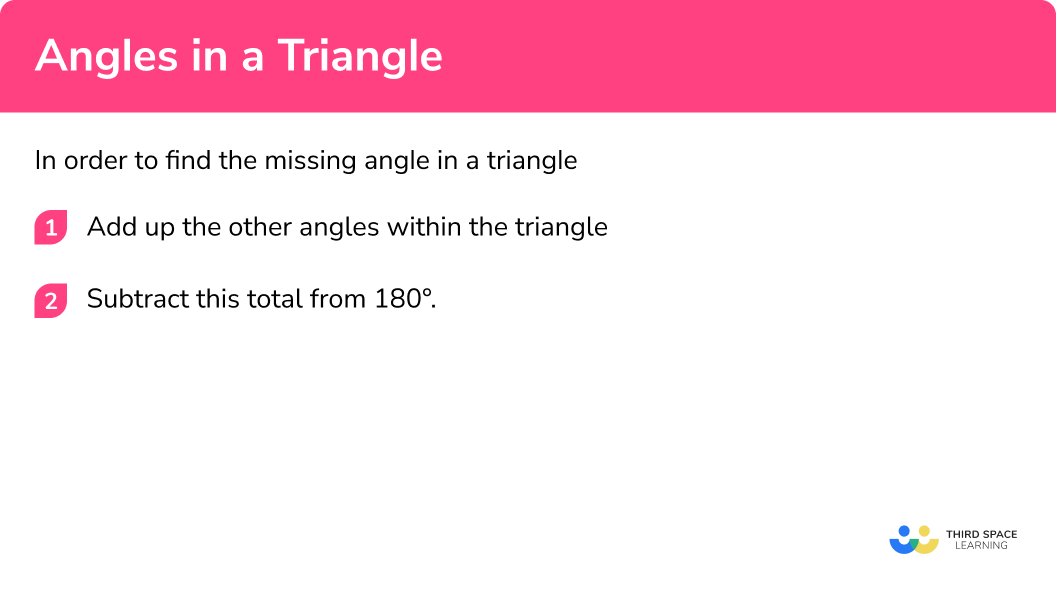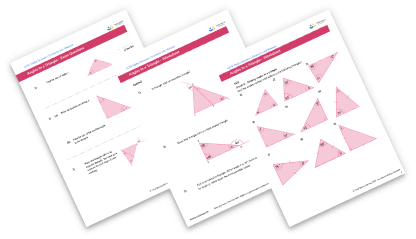One to one maths interventions built for KS4 success
Weekly online one to one GCSE maths revision lessons now available
In order to access this I need to be confident with:
Types of triangles Angles on a straight line, at a point, right angles and opposite angles Forming and solving equationsThis topic is relevant for:

Angles In A Triangle
Here is everything you need to know about angles in a triangle including what the angles in a triangle add up to, how to find missing angles, and how to use this alongside other angle facts to form and solve equations.
There are also angles in a triangle worksheets based on Edexcel, AQA and OCR exam questions, along with further guidance on where to go next if you’re still stuck.
What are angles in a triangle?
All triangles have interior angles that add up to 180º .
Angles in a triangle are the sum (total) of the angles at each vertex in a triangle.
We can use this fact to calculate missing angles by finding the total of the given angles and subtracting it from 180º .
This is true for all types of triangles.
- Right Angle Triangle: One 90° angle, the other two angles will have a total of 90°.
- Isosceles Triangle: Two equal sides and angles.
- Equilateral Triangle: All three angles are 60°.
- Scalene Triangle: All three angles are different.
Examples:
What are angles in a triangle?

How to find a missing angle in a triangle
In order to find the missing angle in a triangle:
- Add up the other angles within the triangle.
- Subtract this total from 180º .
Explain how to find a missing angle in a triangle in 2 steps


Angles in a triangle worksheet

Get your free angles in a triangle worksheet of 20+ questions and answers. Includes reasoning and applied questions.
DOWNLOAD FREE
Angles in a triangle worksheet

Get your free angles in a triangle worksheet of 20+ questions and answers. Includes reasoning and applied questions.
DOWNLOAD FREERelated lessons on angles in polygons
Angles in a triangle is part of our series of lessons to support revision on angles in polygons. You may find it helpful to start with the main angles in polygons lesson for a summary of what to expect, or use the step by step guides below for further detail on individual topics. Other lessons in this series include:
Finding missing angles examples
Example 1: scalene triangle
Work out the size of the angle labelled a in the following triangle.
- We are given the angles 57º and 79º . Add these together.
2Subtract 136º from 180º .
Example 2: right angled triangle
Find the angle labelled b in the following triangle.
We are given the angles 90º and 19º . Add these together.
Subtract 109º from 180º .
Example 3: isosceles triangle
Find the angle labelled c in the following triangle.
When two sides of a triangle are equal, the angles at the ends of those sides will also be equal.
We are given the angle 64º. As this is an isosceles triangle (two equal length sides and two equal angles), the other angle at the bottom will also be 64º .
Subtract 128º from 180º .
How to find one of the two equal angles in an isosceles triangle
- Subtract the given angle from 180º .
- Divide by 2 .
Example 4: equal angles in an isosceles triangle
Find the size of the angle labelled d in the triangle below.
This is an isosceles triangle. We are given one angle and asked to find one of the remaining two angles, which we know are equal.
The other two angles in this triangle add up to 70º .
Since the other two angles in this triangle are equal, we can find d by dividing by 2 .
How to use angle facts to solve problems
Sometimes the problem will involve using other angle facts.
Let’s recap some of the other angle facts we know:
- Use angle facts to fill in any possible angles.
- Use these angles to calculate missing angles in the triangle.
These steps are interchangeable and may need to be repeated for more difficult problems.
Example 5: using angles at a point
Find the size of the angle labelled e .
Here we can use the fact that angles at a point add up to 360º .
Now we know two angles within the triangle, we can find the missing angle.
Example 6: using opposite angles
This time we already know two of the angles in the triangle so we can start by finding the third angle.
We can use the fact that opposite angles are equal to find f .
Example 7: two different triangles
Find the size of the angle labelled g .
We know two of the angles in the right hand triangle and so we can calculate the third.
We can use the fact that angles on a straight line add up to 180º .
Since the sides of the triangle are equal, the left hand triangle is an isosceles triangle and the two angles at the bottom of the triangle are equal. Therefore we can work out the third angle.
How to work out angles in a triangle with algebra
We can use the fact that the angles in a triangle add up to 180º to form equations which we can then solve to find the values of the angles in the triangle.
- Add together the expressions for each angle and simplify.
- Put the simplified expression equal to 180º .
- Solve the equation.
- Substitute your value back in to find the angles in the triangle.
Example 8: angles involving algebra
Find the size of each angle in this triangle.
Add the expressions for each angle.
Put the simplified expression equal to 180º .
Solve the equation.
Work out the angles.
The three angles are 40º , 60º and 80º .
Example 9: angles involving algebra
Find the size of each angle in this right-angled triangle.
Add the expressions for each angle.
Put the simplified expression equal to 180º .
Solve the equation.
Work out the angles.
The three angles are 23º , 67º and 90º .
Common misconceptions
- Incorrect angle sum
Using 360º instead of 180º for the sum of the angles of the triangle.
- Equal angles in an isosceles triangle
Selecting the wrong angles when identifying the equal angles in an isosceles triangle (particularly a problem when the equal angles are not at the bottom). The angle that is different in an isosceles triangle is the one between the two sides with equal length.
Practice angles in a triangle questions
1. Find the angle labelled z in the following triangle.




180-147=33^{\circ}
2. Find the angle labelled y .




This is an isosceles triangle and the two angles at the bottom of the triangle are equal.
51+51=102
180-102=78^{\circ}
3. Find the angle x in the following triangle.




This is an isosceles triangle and the two angles on the right are equal.
180-42=138
138 \div 2 = 69^{\circ}
4. What is the size of each angle in an equilateral triangle?




All three angles in an equilateral triangle are equal so
180 \div 3 = 60^{\circ}
5. Find the size of the angle labelled w in the following triangle.




The angle opposite 24^{\circ} is also 24^{\circ} since vertically opposite angles are equal.
The triangle is an isosceles triangle and the two angles on the left are the same size.
180-24=156
156 \div 2 = 78^{\circ}
6. Find the angle labelled v .




Looking at the left hand triangle frist, we can find the missing angle in that triangle:
90+39=129
180-129=51^{\circ}
We can then use the fact that angles on a straight line add up to 180^{\circ} to find the unlabelled angle in the right hand triangle:
180-51=129^{\circ}
We can then find angle v :
129+31=160^{\circ}
180-160=20^{\circ}
7. Write an equation involving u and use it to find the size of each angle in the following triangle.




Adding the expressions gives us:
2u+20+2u-10+u+5=5u+15
Therefore
\begin{aligned} 5u+15&=180\\\\ 5u&=165\\\\ u&=33^{\circ} \end{aligned}
2 × 33+20=86^{\circ}
2 × 33-10=56^{\circ}
33+5=38^{\circ}
Angles in a triangle GCSE questions
1. Find the size of angle x given that the exterior angle shown is 153^{\circ} .
(2 marks)
(1)
90 + 27 = 177180-117=63^{\circ}
(1)
2. (a) Calculate the size of angle ACE .
(b) Show that BCD is an isosceles triangle.
(5 marks)
(a)
90 + 36 = 126
(1)
180-126=54^{\circ}
(1)
(b)
Angle CBD :
= 180 – 117
=63^{\circ}
Angle BDC :
63 + 54 = 117
180-117=63^{\circ}
(1)
Two angles equal therefore isosceles
(1)
3. Work out the size of the smallest angle in the right angled triangle.
(4 marks)
3x – 10 + 2x + 55 + 90 (= 5x + 135)
(1)
5x + 135 = 180
(1)
x = 9
(1)
3\times 9-10=17^{\circ}
(1)
Learning checklist:
You have now learned how to:
- Use the sum of the angles of a triangle to find missing angles
- Apply other angle facts to find missing angles in triangle problems
- Form and solve equations using the sum of the angles in a triangle
The next lessons are
Still stuck?
Prepare your KS4 students for maths GCSEs success with Third Space Learning. Weekly online one to one GCSE maths revision lessons delivered by expert maths tutors.

Find out more about our GCSE maths tuition programme.